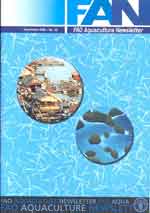
FAO Aquaculture Newsletter No. 36
Aquaculture Management and Conservation Service
Fisheries and Aquaculture Department
 |
FAO Aquaculture Newsletter No. 36Aquaculture Management and Conservation Service Fisheries and Aquaculture Department |
|
FOOD AND AGRICULTURE ORGANIZATION OF THE UNITED NATIONS Rome, December 2006
|
Download ZIP version
![]() - 2,070 Kb
- 2,070 Kb
| The designations employed and the presentation of material in this publication do not imply the expression of any opinion whatsoever on the part of the Food and Agriculture Organization of the United Nations concerning the legal status of any country, territory, city or area or of its authorities, or concerning the delimitation of its frontiers or boundaries. |
All rights reserved. Reproduction and dissemination of material in this information product for educational or other non-commercial purposes are authorized without any prior written permission from the copyright holders provided the source is fully acknowledged. Reproduction of material in this information product for resale or other commercial purposes is prohibited without written permission of the copyright holders. Applications for such permission should be addressed to the Chief, Electronic Publishing Policy and Support Branch, Communication Division , FAO, Viale delle Terme di Caracalla, 00153 Rome, Italy or by email to [email protected]
© FAO 2006
|
Driven by concerns that some forms of aquaculture are environmentally unsustainable, socially
inequitable, and that products are not safe for consumers, there had been attempts, over the
years, to respond to the consequent public perceptions and market requirements. Food safety
standards were elevated and international trade regulations tightened. Policy and regulations
governing environmental sustainability were put in place in many countries, requiring aquaculture
producers to comply with more stringent environmental mitigation and protection measures. In order
to respond to these environmental and consumer concerns on aquaculture production and to secure
better market access, there is increasing interest in certification of aquaculture production systems,
practices, processes and products from aquaculture. |